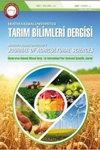四种兰科植物在厩肥中的植物化学分析及抗氧化和抗菌活性
IF 1.1
4区 农林科学
Tarim Bilimleri Dergisi-journal of Agricultural Sciences
Pub Date : 2017-03-14
DOI:10.15832/TBD.64663
引用次数: 7
摘要
以鼠尾草(Salvia officinalis L.)、薰衣草(Lavandula angustifolia L.)、香蜂草(Melissa officinalis L.)和土一枝(Origanum vulgare ssp.)为研究对象,对有机肥料处理后的药用植物挥发油收率、挥发油成分、总酚含量、抗氧化和抗菌活性进行了测定。hirtum (origano)。所调查的药用植物精油得率在0.06±0.01% ~ 3.43±0.06%之间。其中,1,8-桉叶醇(15.285±0.003%)、绿双酚(12.095±0.003%)和顺式图酮(12.200±0.003%)是山茱萸挥发油的主要成分,芳樟醇(22.400±0.003%)、1,8-桉叶醇(8.215±0.003%)、乙酸芳樟醇(7.900±0.003%)和乙酸lavadulyl乙酸酯(7.690±0.003%)是山茱萸挥发油的主要成分,香茅精油(14.515±0.003%)的主要成分;山茱萸的主要成分为香茅醛(13.050±0.003%)和β-石竹烯(12.385±0.003%),山茱萸的主要成分为香芹酚(65.080±0.003%)。hirtum。总酚含量最高,抗氧化活性最高。对金黄色葡萄球菌ATCC 43300、金黄色葡萄球菌ATCC 29213、表皮葡萄球菌ATCC 12228、粪肠球菌ATCC 29212和大肠杆菌ATCC 35218的抑菌活性最好。hirtum。本文章由计算机程序翻译,如有差异,请以英文原文为准。
Phytochemical Analysis, Antioxidant and Antibacterial Activities of Four Lamiaceae Species Cultivated in Barnyard Manure
The present study was conducted to determine essential oil yields, essential oil compositions, total phenolics, antioxidant and antibacterial activities of organic manure-treated medicinal plants of Salvia officinalis L. (sage), Lavandula angustifolia L. (lavender), Melissa officinalis L. (lemon balm) and Origanum vulgare ssp. hirtum (origano). Essential oil yields of investigated medicinal plants varied between 0.06±0.01%-3.43±0.06%. The 1,8-cineol (15.285±0.003%), viridiflorol (12.095±0.003%) and cis-thujone (12.200±0.003%) were the major essential oil components in S. officinalis L. Linalool (22.400±0.003%) 1,8-cineol (8.215±0.003%), linalyl acetate (7.900±0.003%) and lavadulyl acetate (7.690±0.003%) were the major components in L. angustifolia L. Citronellal (14.515±0.003%), geranial (13.050±0.003%) and β-caryophyllene (12.385±0.003%) were the major components in M. officinalis L. and carvacrol (65.080±0.003%) was the major component in O. vulgare ssp. hirtum. The highest total phenolics content and antioxidant activity were observed in M. officinalis. The best antibacterial activity against Staphylococcus aureus ATCC 43300, Staphylococcus aureus ATCC 29213, Staphylococcus epidermidis ATCC 12228, Enterococcus faecalis ATCC 29212 and Escherichia coli ATCC 35218 bacteria was observed in O. vulgare ssp. hirtum.
求助全文
通过发布文献求助,成功后即可免费获取论文全文。
去求助
来源期刊
CiteScore
1.40
自引率
0.00%
发文量
26
期刊介绍:
Journal of Agricultural Sciences (JAS) is an international, double-blind peer-reviewed, open-access journal, published by the Faculty of Agriculture, Ankara University. The journal invites original research papers containing new insight into any aspect of Agricultural Sciences that are not published or not being considered for publication elsewhere. Preliminary, confirmatory or inconclusive research, review articles, case and local studies and works presenting taxonomy will not be published.

 求助内容:
求助内容: 应助结果提醒方式:
应助结果提醒方式:


